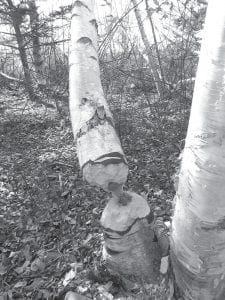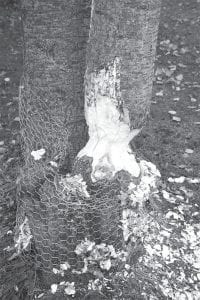With the Grand Marais Recreation Park pretty much free from guests the nearby beaver have been busy cutting down trees during the night. Even though the park staff has placed chicken wire around the base of many trees, it does little to deter the brainy, brawny beaver. It might be said that the park staff faces a “gnawing” problem and it is hard to get to the “teeth” of the matter.

Those scrumptious trees with the chicken wire fencing around the base of them are coming down. So say the beaver, who have been working nightly to clear the Grand Marais Recreation Park of some of its forest areas and planted trees at campsites.
Big or tall, short and small, makes no difference to the beaver who seem to prefer to log-off the saplings fitted with “beaver protection” by the park staff.
How successful has the logging operation been? I counted no less than 15 birches and poplar that have been downed or will soon be gnawed to the ground in the last week. If they become any more productive, there will be a crew of timber bosses down at the park vying with each other to hire these furry little lumberjacks.
Dave Tersteeg, Grand Marais park manager, has spent years working to solve the dilemma of saving the trees and saving the beaver. So far the beaver seem plenty safe, but the trees, not so much.
Building wire fences around the trees, even several feet high, hasn’t worked. If you put the wire fencing any higher, it will be hard to tell where the metal ends and the tree begins. That’s a hard sell to a tourist park that offers the breathtaking natural beauty the recreation park provides.
The Grand Marais campground and RV park have 300 campsites, a recreation hall, ball field, Sweetheart’s Bluff nature area with hiking trails, picnic pavilion, and a municipal marina with two public water accesses. It’s chock-full of people for the five warmest months, but once the people go away, the beaver – before too much snow flies — get in there and go to work.
Once the trees are harvested and gnawed to length, the beaver drag them to the harbor and push them across the bay to their beaver lodge by the Coast Guard station. The lodge is made up of thousands of sticks, branches, and small logs, and is held together by mud, a great piece of engineering.
Of course, there is a way to solve the nuisance beaver problem without hurting them. In the 1940s the state of Idaho caught nuisance beaver, packed them into boxes, then parachuted them to places where there was no beaver, and North America’s largest rodents prevented erosion by damming streams that were above farms.
We don’t have many farms here, and beaver seem to be everywhere, but it sure would be fun to see them parachuting from the sky — right back into the Grand Marais harbor, their home. Yes, more trees will be lost. Maybe plant some sacrificial trees. They could be exceptionally well marked. They will be the trees with the chicken wire wrapped around the base of them, so the beaver know which trees are theirs.
Fun facts about beaver from the Science Kids website:
. Beavers’ front teeth never stop growing. When beaver gnaw on wood it keeps their teeth from getting too long.
. Beavers are mainly nocturnal.
. There are two types of beavers. The Eurasian beaver (Castor fiber) and the North American beaver (Castor Canadensis).
. Worldwide, only the capybara is a larger rodent.
. There are usually two dens in a beaver lodge. One is for drying off after coming through the underwater entrance, and the other is where a family of up to four adults and six to eight young live.
. Beavers can stay underwater for up to 15 minutes.
. Beaver, which have poor eyesight, have transparent eyelids which allow them to see underwater.
. Adult beavers can weigh up to 55 pounds and grow to a length of three feet. Females are as large or larger than males of the same age.
. In the wild beaver can live up to 24 years. . Beavers slap their tails on the water to warn other beaver of danger approaching.
. Beavers are herbivores who eat the wood of trees and also eat pondweed and water lilies.
. The beaver is the national animal of Canada.
. At one time there was 60 million beaver in North America, but due to hunting and trapping their numbers have fallen to 12 million.



Leave a Reply